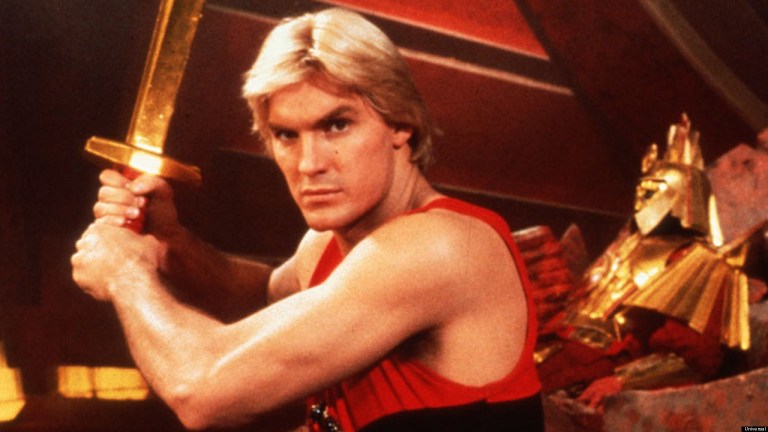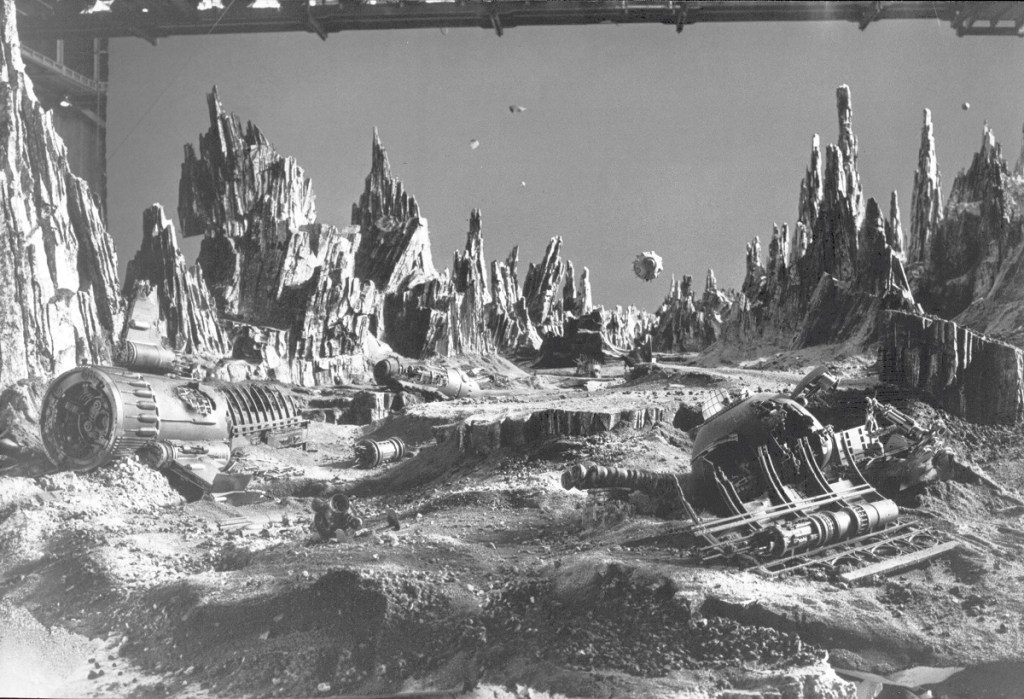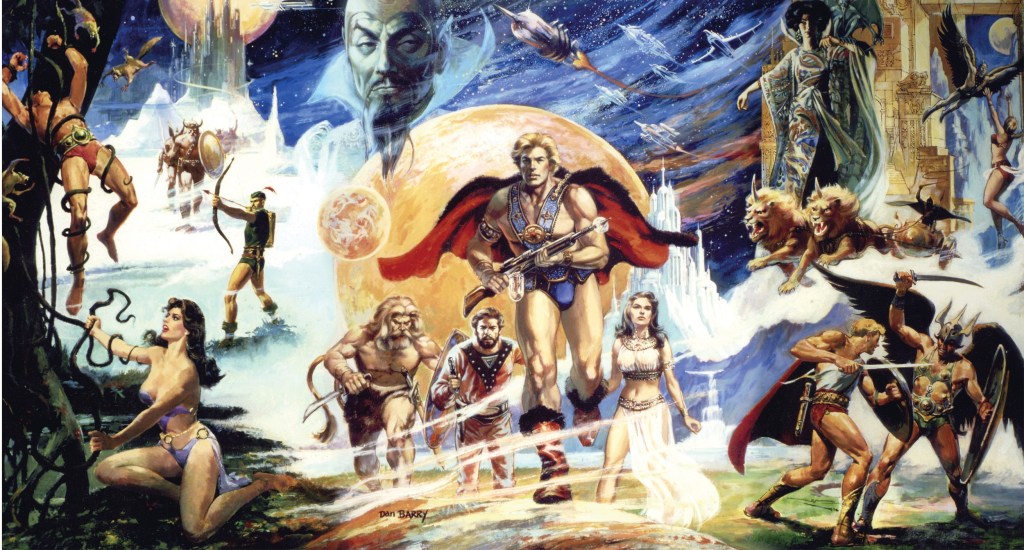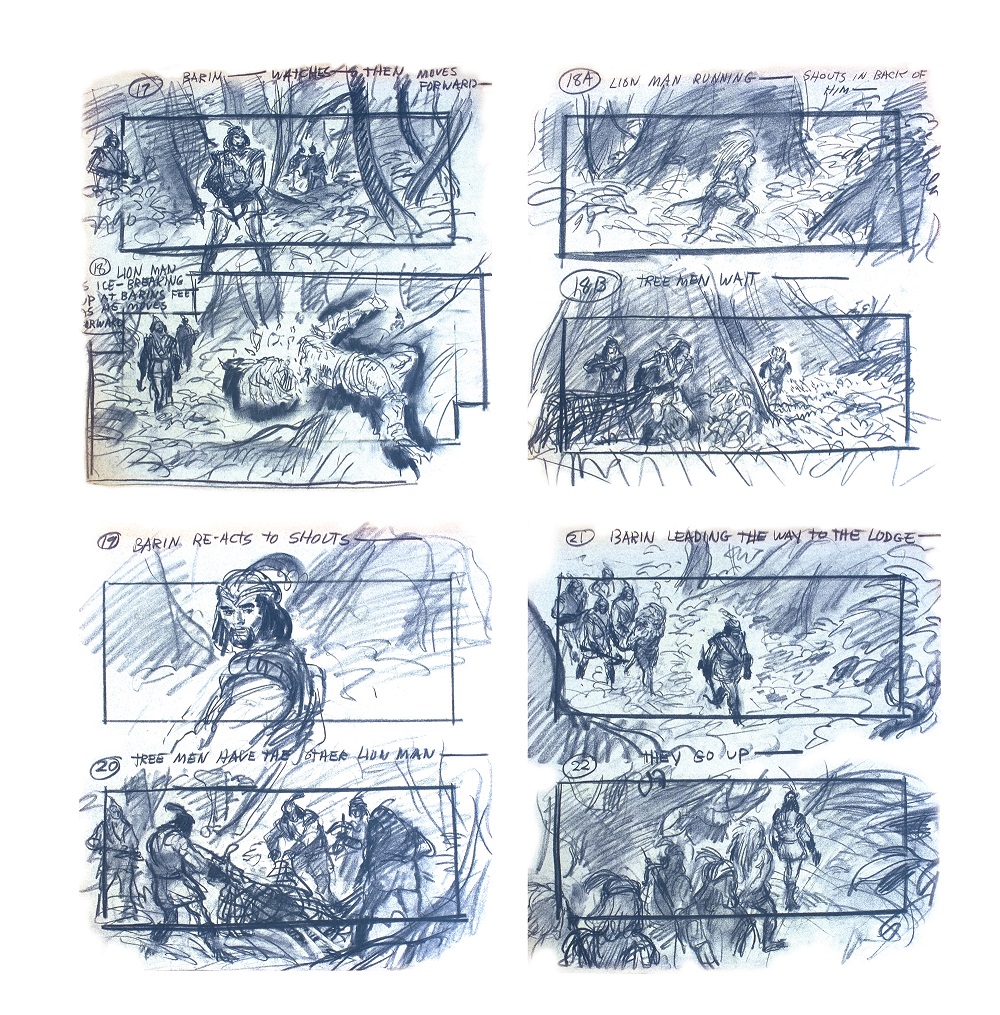Flash Gordon’s Original Ending Revealed
We talked to John Walsh, the author of Flash Gordon: The Official Story of the Film, about how he uncovered the truth behind the making of a cult classic.

Following our enlightening Flash Gordon 40th anniversary interview with the film’s director, Mike Hodges, we got to have an in-depth conversation with author John Walsh. Titan Books published Walsh’s exhaustive coffee table book Flash Gordon: The Official Story of the Film last November. It was a labor of love for Walsh that delves into the making of the movie and celebrates its enduring appeal.
Walsh is a Trustee of the Ray and Diana Harryhausen Foundation, and was also behind the BBC’s critically acclaimed documentary series Sofa Surfers, which explored childhood homelessness, and the BAFTA-nominated film My Life: Karate Kids, which tackled issues of bullying among disabled children.
Den of Geek: You’ve been involved with preserving the legacy of the late Ray Harryhausen, and your first book through Titan was about some of his work. You first met him at film school in the 80s?
John Walsh: That’s right. I was BBC Young Filmmaker of the Year when I was 15. I was offered a place in London Film School when I was doing my A-levels and they sort of scooped me up. At the end of your first year you do a 16mm documentary film. I found Ray Harryhausen‘s name in the London telephone directory. I asked my parents for permission to use the phone, as you did in those days. My mom said “Ring after six when it’s cheaper.” So I rang him up and said “I’m making a film about your life and work” and he was very gracious about it.
I went to see him. I’d done some very basic animation as a youngster but was fascinated by all his creatures and everything else. We stayed in touch over the years. He asked me to become a trustee of his foundation, so I’ve been helping to look after the vast collection, which is the largest of its kind outside of the Walt Disney Company. His daughter, Vanessa Harryhausen, and I run it with one member of paid staff. Then I did the book – Harryhausen: The Lost Movies.
At what point did you decide that Flash Gordon was next for the John Walsh treatment?
The Lost Movies was stories about films that we think we know but hadn’t been told. Titan are very good at making books on our favorite films – like Dark Crystal and Labyrinth – and those films which maybe we liked on VHS but weren’t successful when they came out theatrically. I was just thinking, gosh, no one has done a Flash Gordon book yet.
It took about eight months to get Universal Pictures and King Features, who were the rights holders for the Flash Gordon character, and Studio Canal, who now own the physical asset of that 1980 film, to come together and put a deal together.
What happened after the deal was done?
I thought “they’ll give me all their photos because there’ll be a gazillion photos in the archive” – I got the shock of my life when there were no photos or any assets worth putting into a book! I was like “oh no, what have I done?” I drank from the poison chalice to some extent, because I thought that the work had finished when we got the rights, and it had really just started.
Universal Pictures had some of the publicity photos, but not enough to put into a book like this. Nothing ‘behind the scenes’. I went begging around the world asking fans and different people, “please may I have your pictures if I credit you in the book?” A big part of the introduction of the book ended up being the story of how the assets had been dispersed or thrown away. The film cost three times what Star Wars cost. It cost somewhere in the region of $35 million. The idea that nobody kept any of the assets from it, the original artworks for the paintings, for the posters – gone. The models, gone. The costumes were mostly gone.

It kept me up at night. I was genuinely quite worried about whether we’d get enough high quality images that would be good enough, but ultimately I got everything I wanted. I even managed to get a high quality unpublished image of Queen from 1980 for a publicity round they did in Japan. Virtually every page has something unseen, never before published, recently found.
It was around the clock. Sometimes it took 20 or 30 hours just to get one image. It was pretty all labor intensive. The easiest part was speaking to the people like the actors, but another problem existed there as well. If you take the Star Wars universe as a comparison, the various actors and filmmakers speak so regularly that you can pretty much find a consensus on how things happened and where they happened. But on this, [lead actor] Sam Jones – naughty, naughty Sam Jones! – lovely Sam Jones, and Brian Blessed…
Brian tends to be quite creative, doesn’t he? Every time he tells a story there’s a new spin on it.
Mike [Hodges, director], told me “It’s not true what Brian says in your book that he directed one of the fight sequences.” He said “I love Brian dearly but there’s no way he directed one of the fight sequences. I was there every day and I never would have allowed him to do that. It’s just not what happened.” So between Brian and Sam, they’ve kind of filled in the gaps. As actors often do, they will inflate their parts!
Some other bits are true. Sam did get stitches, and Dino [De Laurentiis, producer] was ready to kill someone. Two days before principal photography, there’s the lead actor getting stitches in his face.
When I was researching the film for our piece, I couldn’t really establish how much of Sam’s audio had been replaced in post-production.
Some of Sam’s dialogue is in there! Some has been voiced on top of his voice, and some is a completely different actor in different places. If you were to cut together the different sounds and hear them all together, they sound higher and then lower.
There isn’t actually a record of who the actors are, not because anyone is trying to create conspiracy around it all, it’s just that’s one of the many assets of the film that were tossed aside. It’s more than one [other voice] Mike told me.
That’s new information to me. I knew that there was one other; I didn’t know there was more than one!
It’s more than one, and it’s Sam as well. There are at least three voices that make up Sam’s dialogue. There’s kind of a little Frankenstein’s Monster of dialogue in most places for Sam.
Do you remember the first time you watched Flash Gordon?
Yes, it was a good movie at the time. I loved anything with science fiction! I’ll tell you what I was disappointed by: there were no robots. To me, if it had a robot in it I was like, “that’s it, I’m there, I want to buy the robot from that film.” So, I was kind of disappointed. There are no robots.
I was obsessed with the Superman movie and how the flying sequences were created at the time. When this film came out, I thought “this is going to be better than Superman, it’s got hundreds of people flying.” But the flying sequences aren’t as sophisticated in this as they are in Superman, so my first time seeing Flash Gordon was tinged with a kind of geek boy technical disappointment about some of those aspects, and no robots. I haven’t told anyone that.
When researching the book, what ended up being the most surprising revelation?
There were two big moments. The first was when I discovered there had been an entirely different film planned – and we got the artwork, it’s in the book. Then, I found out that the film was supposed to have an entirely different ending.
Where the film ends now, at the wedding crashing, that was the start of a new major sequence that was going to involve Ming turning into fabulous creatures and fighting Flash, the Hawkmen and the Arboria Tree Men. It all had to be cut. Literally, the pages were pulled. They were like “no time for that, haven’t got time for that.” They had the money for it, but no time.
At the back of my book are all of those scenes, and in some cases photos of scenes they shot that were cut because they couldn’t complete the effects for them, and then comprehensive storyboards with major characters like Lion Man, who was going to accompany Flash Gordon throughout the film like a Chewbacca character.
Wasn’t Lion Man in the cartoons as well as the serial?
Yes. We got the original artwork from when Dino was going to make the film for Paramount Pictures. It shows Lion Man as part of this fantasy concept poster.

When I talked to Mike last year, he still seemed somewhat baffled that he was the one who was chosen to take over from Nicolas Roeg as director. Do you think that Nic’s original vision would have worked on screen if Dino had just gone along with it?
No. For tax purposes it was very difficult to get a director in from America to do a picture, particularly in the late 70s. It was a big tax kerfuffle. British directors who’ve done major Hollywood films would have included Alan Parker, maybe John Boorman, Ridley Scott. Nic Roeg and Mike Hodges were the right fit, even though they hadn’t done special effects films.
Roeg’s version couldn’t have worked because the content was adult in tone, and also he came up with some concepts that were outside of the comic strip that would have made it much more adult-themed as well. For an audience to have followed it and enjoyed it and for the film to have had a chance to make back it’s $35 million, I think he was right to pull the plug on the Nic Roeg version. It needed to be a film that had a much broader base to make that money back. There were two sequels planned!
And Mike was originally brought in as an option for the second film.
Yes, that’s right. It was Roeg who suggested him, because he knew Mike and thought Mike would be a good fit. Mike had just been sacked from Omen II so he was suddenly available at the point when Dino parted company with Nic. It wasn’t a marriage of convenience, he was the right fit.
Dino did this thing where if he liked your face, then you got the part or you got the work. It wasn’t about having a pretty face or anything, it was if he thought your face was sympathetic. It’s kind of an Italian superstition that you can kind of trust a man by his face. Dino wouldn’t get on an airplane if he looked at the pilot and didn’t like their face.
Wow.
Your natural instincts are often right. Dino’s were often right. He said to Mike, “I like-a your face Mike, and that’s why I chose you for this-a film.” Doing a very credible Italian accent there! I interviewed [Dino’s wife] Martha extensively for the book – she said Dino would have liked my face.
We’ve heard so many myths and legends about the Flash Gordon sequels. It seems like everyone you talk to has heard a rumor about what the story would have been. Has your own research revealed any new sequel information?
Dino had great, great plans. Dino’s plan was to buy Pinewood Studios and to film three Flash Gordons back to back. That’s ambitious by any movie standard, isn’t it?
Brian Blessed first put me on the trail of what the second film would have been about – it was going to be Flash Gordon’s Trip to Mars – based on the second cinema serial. In that, Flash Gordon meets the Clay Men and other people on Mars where Ming has set up base.

40 years on, what do you think the enduring appeal of the movie is?
Flash Gordon has survived the critique of not having state of the art special effects. It’s a much more fun film to get into than Empire Strikes Back and Star Trek: The Motion Picture – two comparable big budget films of the era – as they’re kind of heavy going.
This film was also perceived to be a Christmas film, it premiered at Christmas and received it’s TV premiere in 1983 on the BBC at Christmas. So for most people, it has a special Christmas vibe and a happy vibe about it. It looks like a Christmas ornament.
It’s separate from other science fiction films of the time, it went in the opposite direction: rock score, kind of camp humor, brighter lit with more colors. There isn’t another film you could compare it with, except Barbarella from the 60s.
Recently, it’s come into criticism for its racial stereotyping – Ming playing effectively as a Chinese Fu Manchu character.
Yes, the BBFC has added a warning to the film now. Has the problematic nature of Ming’s portrayal changed the way you view the film?
For me it hasn’t, because when Max von Sydow played the part he didn’t have a darkening of his skin. That’s his natural facial pallor. The accent he chose is English – he decided to speak it as an English officer or an English monarch. There’s quite a kind of clash of cultures there. The facial makeup and the costume itself is definitely Red China from 1936, as Alex Raymond had envisaged.
But I think it’s quite right the film should have a warning. I don’t think the film should be stopped, or that he should be pixelated out. I think Dino and Mike Hodges chose the best actors from the time to play these roles. You needed people who had played hard roles in films before. If they remake Flash Gordon, then I’ll be quite happy to see someone of Southeast Asian origin in the role of Ming. I think that would be spectacular.
There are levels to which this works and doesn’t work. The more extreme argument is “you wouldn’t cast a serial killer as a killer would you?” Well no, because if you’re casting for Dennis Nielsen you cast a good actor. David Tennant happens to be Scottish. I’m sorry he’s not a serial killer in real life.
That we know of, John.
That we know of. You can never trust actors, you know? Never leave them on their own in a room. But yes, I think where it’s possible and where it’s practical, it’s respectful.
Have you made any decisions about what you would like to do next, now we’ve had your take on Harryhausen, and Flash Gordon?
I’m literally in the process of delivering a manuscript for my next book. It comes out in September!
I will definitely check it out. Thank you, you’ve been brilliant.
Flash Gordon: The Official Story of the Film is available now from Titan Books. You can check out John’s The Official Story of the Film Podcast right here.
This interview has been edited for clarity.
Subscribe to Den of Geek magazine for FREE right here!
